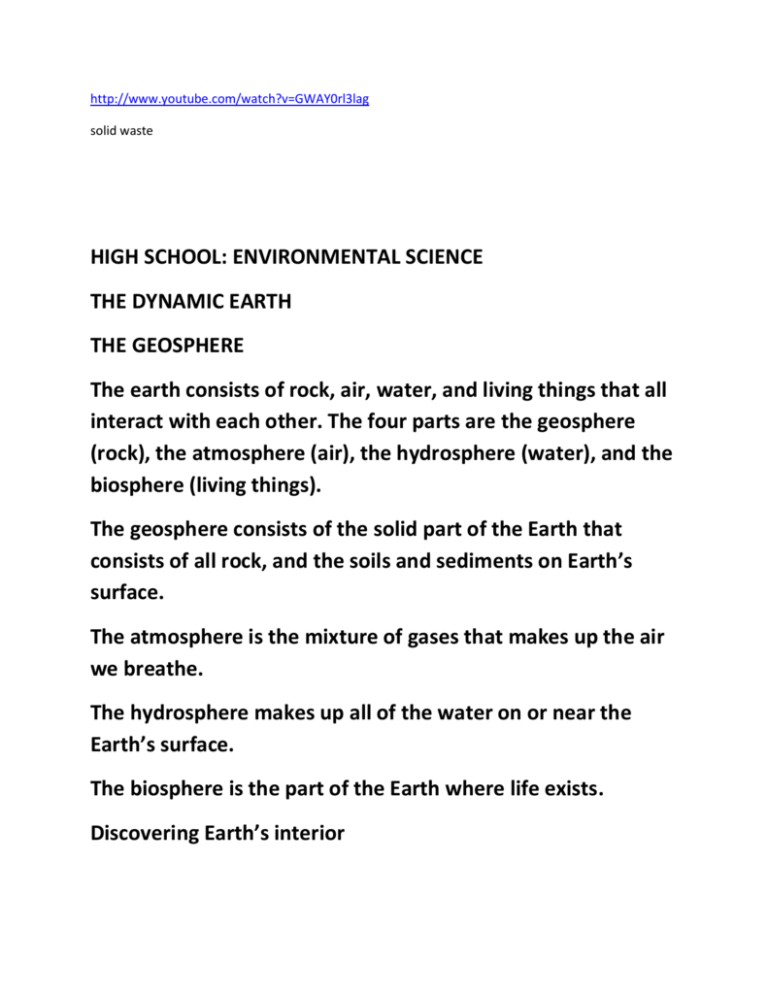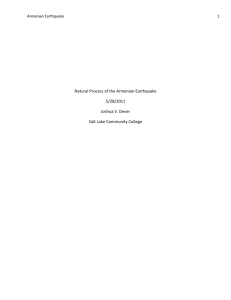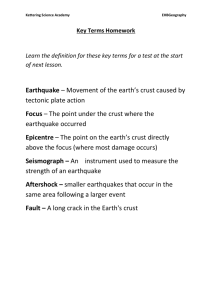GEOSPHERE PR - Bioenviroclasswiki
advertisement

http://www.youtube.com/watch?v=GWAY0rl3lag solid waste HIGH SCHOOL: ENVIRONMENTAL SCIENCE THE DYNAMIC EARTH THE GEOSPHERE The earth consists of rock, air, water, and living things that all interact with each other. The four parts are the geosphere (rock), the atmosphere (air), the hydrosphere (water), and the biosphere (living things). The geosphere consists of the solid part of the Earth that consists of all rock, and the soils and sediments on Earth’s surface. The atmosphere is the mixture of gases that makes up the air we breathe. The hydrosphere makes up all of the water on or near the Earth’s surface. The biosphere is the part of the Earth where life exists. Discovering Earth’s interior Scientists can use seismic waves to learn about Earth’s interior. Seismic waves are the waves that travel through Earth’s interior during an earthquake. A seismic wave is altered by the nature of the material through which it travels. Seismologists measure changes in the speed and direction of seismic waves that penetrate the interior of the planet. In this way seismologists have learned that Earth is made up of different layers and have learnt what substances make up each layer. http://science.howstuffworks.com/earthquake4.htm Extra information on seismic waves http://www.youtube.com/watch?v=yOGoKCK17a4&feature=r elated video on seismic waves and its impact The composition of the Earth Scientists divide the Earth into three layers – the crust, the mantle, and the core – based on the composition of each layer. The crust is Earth’s thin outer layer is the crust. It is made almost entirely of light elements. The crust is Earth’s thinnest layer. The mantle, which is the layer beneath the crust is made of ricks of medium density. (iron-rich minerals) Earth’s innermost layer is the core. The core is composed of the densest elements. (nickel and iron) http://www.youtube.com/watch?v=0AAITe0MImY layers of earth (a person teaching students) http://www.youtube.com/watch?v=6PDvjhELGdE&feature=re lated layers of earth (earthquake)shown The structure of the Earth The Earth can be divided into five layers based on the physical properties of each layer. Earth’s outer layer is the lithosphere. It is 15 Km to 300 Km thick. It consists of the crust and the rigid, uppermost part of the mantle. It is divided into huge pieces called tectonic plates. It can have both continental and oceanic crust. The layer beneath the lithosphere is the asthenosphere. It is the solid plastic layer of the mantle between the mesosphere and the lithosphere. It is made of mantle rock that flows very slowly, which allows tectonic plates to move on top of it. Beneath the asthenosphere is the mesosphere, the lower part of the mantle. The Earth’s outer core is a dense liquid layer. At the center of the Earth is the dense, solid inner core, which is made up mostly of the metals iron and nickel. The temperature of the inner core is estimated to be between 4,0000C to 5,0000C. Even though the inner core is so hot, it is solid because it is under enormous pressure. Earth’s outer and inner core together make up about one third of Earth’s mass. Plate tectonics http://www.odsn.de/odsn/services/paleomap/animation.ht ml Plate tectonics Pangaea The lithosphere – the rigid outermost layer of the Earth- is divided into pieces called tectonic plates. These plates glide across the underlying asthenosphere. The continents are located on tectonic plates and move around with them. The major tectonic plates include the Pacific, North American, South American, African, Eurasian, and Antarctic plates. Much of the geologic activity at the surface of the Earth takes place at the boundaries between tectonic plates. Plates may separate from one another, collide with one another, or slip past one another. Enormous forces are generated at tectonic plate boundaries, where the crust is pulled apart, is squeezed together, or is constantly slipping. The forces produced at the boundaries of tectonic plates can cause mountains to form, earthquakes to shake the crust, and volcanoes to erupt. http://video.yahoo.com/watch/1595682/5390276 Plate tectonics (*) Tectonic plates are continually moving around the Earth’s surface. When tectonic plates collide, slip by one another, or pull apart, enormous forces cause rock to break and buckle. Where plates collide, the crust becomes thicker and eventually forms mountain ranges. The Himalaya Mountains, began to form when the tectonic plate containing Asia and the tectonic plate containing India began to collide 50 million years ago. http://www.learner.org/interactives/dynamicearth/slip2.htm l formation of mountain animation Earthquakes http://www.weatherwizkids.com/earthquake1.htm information regarding earthquakes A fault is a break in the Earth’s crust along which blocks of the crust slide relative to one another. When rocks that are under stress suddenly break along a fault, a series of ground vibrations is set off. These vibrations of the Earth’s crust caused by slippage along a fault are known as earthquakes. Earthquakes are occurring all the time, but many are so small that we cannot feel them. Other earthquakes are enormous movements of the Earth’s crust that cause widespread damage. The Richter scale is used by scientists to quantify the amount of energy released by an earthquake. The smallest magnitude that can be felt is approximately 2.0, and the largest that has ever been recorded is 9.5. Each increase of magnitude by one whole number indicates the release of 31.7 times more energy than the whole number below it. Earthquakes that cause widespread damage have magnitudes of 7.0 and greater. The majority of earthquakes takes place at or near tectonic plate boundaries because of the enormous stresses that are generated when tectonic plates separate, collide, or slip past each other. Over the past 15 million to 20 million years, large numbers of earthquakes have occurred along the San Andreas fault, which runs almost the entire length of California. The San Andreas fault is the line where parts of the North American plate and the Pacific plate are slipping past one another. Earthquake hazard http://www.geo.mtu.edu/UPSeis/hazards.html The Effect of Ground Shaking The first main earthquake hazard (danger) is the effect of ground shaking. Buildings can be damaged by the shaking itself or by the ground beneath them settling to a different level than it was before the earthquake (subsidence). FIGURE 1 - THESE MEN BARELY ESCAPED WHEN THE FRONT OF THE ANCHORAGE J.C. PENNY'S COLLAPSED DURING THE 1964 GOOD FRIDAY EARTHQUAKE. Buildings can even sink into the ground if soil liquefaction occurs. Liquefaction is the mixing of sand or soil and groundwater (water underground) during the shaking of a moderate or strong earthquake. When the water and soil are mixed, the ground becomes very soft and acts similar to quicksand. If liquefaction occurs under a building, it may start to lean, tip over, or sink several feet. The ground firms up again after the earthquake has past and the water has settled back down to its usual place deeper in the ground. Liquefaction is a hazard in areas that have groundwater near the surface and sandy soil. Buildings can also be damaged by strong surface waves making the ground heave and lurch. Any buildings in the path of these surface waves can lean or tip over from all the movement. The ground shaking may also cause landslides, mudslides, and avalanches on steeper hills or mountains, all of which can damage buildings and hurt people. The second main earthquake hazard is ground displacement (ground movement) along a fault. If a structure (a building, road, etc.) is built across a fault, the ground displacement during an earthquake could seriously damage or rip apart that structure. From Figure 4 you can tell that the San Andreas Fault is a right-lateral transverse (strike-slip) fault because the other side of the road (on the opposite side of the fault) has moved to the right, relative to the photographer's position. FIGURE 4 - THIS ROAD, WHICH CROSSES THE SAN ANDREAS FAULT, WAS CUT IN HALF BY THE 1906 EARTHQUAKE. ONE END OF THE ROAD SLID 20 FEET (6.5 METERS) PAST THE OTHER DURING THE QUAKE. Flooding The third main hazard is flooding. An earthquake can rupture (break) dams or levees along a river. The water from the river or the reservoir would then flood the area, damaging buildings and maybe sweeping away or drowning people. Tsunamis and seiches can also cause a great deal of damage. A tsunami is what most people call a tidal wave, but it has nothing to do with the tides on the ocean. It is a huge wave caused by an earthquake under the ocean. Tsunamis can be tens of feet high when they hit the shore and can do enormous damage to the coastline. Seiches are like small tsunamis. They occur on lakes that are shaken by the earthquake and are usually only a few feet high, but they can still flood or knock down houses, and tip over trees. Fire The fourth main earthquake hazard is fire. These fires can be started by broken gas lines and power lines, or tipped over wood or coal stoves. They can be a serious problem, especially if the water lines that feed the fire hydrants are broken, too. For example, after the Great San Francisco Earthquake in 1906, the city burned for three days. Most of the city was destroyed and 250,000 people were left homeless FIGURE 6 - SAN FRANCISCO BURNING AFTER THE 1906 EARTHQUAKE. Most of the hazards to people come from man-made structures themselves and the shaking they receive from the earthquake. The real dangers to people are being crushed in a collapsing building, drowning in a flood caused by a broken dam or levee, getting buried under a landslide, or being burned in a fire. http://www.authorstream.com/presentation/Dr_Dave113874-hazards-sichuan-earthquake-landslide-china-disasterhazard-conference-07-11-philip-allen-1-entertainment-pptpowerpoint/ Hazards of earthquake powerpoint Earthquakes are not restricted to high-risk areas. In 1886, an earthquake shook Charleston, South Carolina, which is considered to be in a medium-risk area. Because the soil beneath the city is sandy, this earthquake caused extensive damage. During shaking from a strong earthquake, sand acts like a liquid and causes buildings to sink. In areas that are prone to earthquakes, it is worth the extra investment to build bridges and buildings that are at least partially earthquake resistant. Earthquake-resistant buildings are slightly flexible so that they can sway with the ground motion. VOLCANOES A volcano is a mountain built from magma-melted rock-that rises from the Earth’s interior to the surface. Volcanoes are often located near tectonic plate boundaries where plates are either colliding or separating from one another. Volcanoes may occur on land or under the sea, where they eventually break the ocean surface as islands. The majority of the world’s active volcanoes on land are located along tectonic plate boundaries that surround the Pacific Ocean. http://www.youtube.com/watch?v=y4KbyB2UnTM volcanic eruption (song) http://www.youtube.com/watch?v=bYYgx8Wo6UQ&feature= related Mount Etna volcanic eruption (*) http://www.youtube.com/watch?v=GwLYFwjhgaw Video on Mount St. Helens Local effects of volcanic eruptions http://library.thinkquest.org/17457/volcanoes/effects.php Volcanic eruptions can be devastating to local economies and cause great human loss. Clouds of hot ash, dust, and gases can flow down the slope of a volcano at great speed and cause great damage to everything in their path. During an eruption, volcanic ash can mix with water and produce a mudflow. In 1985, Nevado del Ruiz in Columbia erupted, melting ice at the volcano’s summit. A mudflow raced downhill and engulfed the town of Armero. The ash that falls to the ground can cause buildings to collapse under its weight, bury crops, and damage the engines of vehicles. Volcanic ash may also cause breathing difficulties Global effects of volcanic eruptions Major volcanic eruptions, such as the eruption of Mount St. Helens can change Earth’s climate for several years. In large eruptions, clouds of volcanic ash and sulfur-rich gases may reach the upper atmosphere. As the ash and gases spread across the planet, they can reduce the amount of sunlight that reaches the Earth’s surface. This reduction in sunlight can cause a drop in the average global surface temperature. In the 1991 eruption of Mount Pinatubo in the Philippines, large clouds of ash and gases entered the Earth’s atmosphere. The amount of sunlight that reached the Earth’s surface was estimated to have decreased by 2 to 4 percent. As a result, the average global temperature dropped by several tenths of a degree Celsius over a period of several years. Erosion The removal and transport of surface material is called erosion. Erosion wears down rocks and makes them smoother as time passes. The older a mountain range is, the longer the forces of erosion have acted on it. the round-topped Appalachian mountains in the eastern United States are older than the jagged Rocky Mountains in the west. Water erosion Erosion by both rivers and oceans can produce dramatic changes on Earth’s surface. Waves from ocean storms can erode coastlines to give rise to a variety of spectacular landforms. Over time, rivers can carve deep gorges into the landscape. Wind erosion Wind can change the landscape of our planet. In places where plants grow, their roots hold soil in place. But in places where there are few plants, wind can blow soil away very quickly. Beaches and deserts which have loose, sandy soil, are examples of places where few plants grow. Soft rocks, such as sandstone, erode more easily than hard rocks, such as granite, do. Explosive volcanic eruptions pose both short-term and long-term hazards. Lava flows and lahars can wipe out the flanks of mountainsides. Volcanic ash can blanket the landscape for miles, and ash clouds can disrupt aircraft travel, such as the incident in 1989 when ash from Alaska's Redoubt volcano temporarily disabled a passenger airplane. On longer time scales, eruptions can inject massive quantities of ash into the atmosphere, greatly reducing the solar heating of the Earth and potentially interrupting the global food supply for several years. In 1991, mount Pinatubo in the Philippines erupted, and strong winds spread the aerosol particles from the plume around the globe. The result was a measurable cooling of the Earth's surface for a period of almost two years. The role of natural hazards research and developing applications to mitigate the effects of disasters has global implications for reducing loss and saving lives. Expected Accomplishments:








